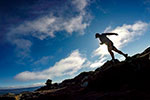Trail Runners versus Hiking Shoes
Forum rules
TIP: The online Bushwalk Inventory System can help bushwalkers with a variety of bushwalk planning tasks, including: Manage which items they take bushwalking so that they do not forget anything they might need, plan meals for their walks, and automatically compile food/fuel shopping lists (lists of consumables) required to make and cook the meals for each walk. It is particularly useful for planning for groups who share food or other items, but is also useful for individual walkers.
TIP: The online Bushwalk Inventory System can help bushwalkers with a variety of bushwalk planning tasks, including: Manage which items they take bushwalking so that they do not forget anything they might need, plan meals for their walks, and automatically compile food/fuel shopping lists (lists of consumables) required to make and cook the meals for each walk. It is particularly useful for planning for groups who share food or other items, but is also useful for individual walkers.
46 posts
• Page 2 of 2 • 1, 2
Re: Trail Runners versus Hiking Shoes
PS Transitioned form Full leather boots, to canvass style boots to Inov8 to Five fingers over 20 years of hiking in Tassie.
-

Penguin - Phyllocladus aspleniifolius

- Posts: 777
- Joined: Sun 15 Jul, 2007 9:47 pm
Re: Trail Runners versus Hiking Shoes
What I am curious about is who convinced a generation of people that they needed "ankle support?" I guess the same people who convinced us that we need to walk with our heels lifted rather than in a zero drop shoe.
A guy called Harper who founded the Altra company was (apparently) responsible for the zero drop idea, but it started off pretty much as a gimmick, to increase sales. What else did you expect?
It was Nike Marketing who spawned these three really bad ideas
Ankle support
Pronation control
Arch support
None of these had any published support from the medical/scientific literature: they were just Nike marketing ideas to grab market share. But they seem to have become self-perpetuating memes, like 'zero-drop'.
Actually, all three are medically BAD. 'Ankle support' ruins the strength of your ankle muscles and can cause accidents. 'Pronation control' fights your natural ankle articulation, and can cause damage. 'Arch support' causes injury to the big muscle under your foot by banging on it when you walk.
'Zero-drop' can also cause damage to your muscles and tendons if you just jump into it. It gives no benefit in practice.
But the Marketing Depts are only concerned about getting more sales.
Cheers
Roger
A guy called Harper who founded the Altra company was (apparently) responsible for the zero drop idea, but it started off pretty much as a gimmick, to increase sales. What else did you expect?
It was Nike Marketing who spawned these three really bad ideas
Ankle support
Pronation control
Arch support
None of these had any published support from the medical/scientific literature: they were just Nike marketing ideas to grab market share. But they seem to have become self-perpetuating memes, like 'zero-drop'.
Actually, all three are medically BAD. 'Ankle support' ruins the strength of your ankle muscles and can cause accidents. 'Pronation control' fights your natural ankle articulation, and can cause damage. 'Arch support' causes injury to the big muscle under your foot by banging on it when you walk.
'Zero-drop' can also cause damage to your muscles and tendons if you just jump into it. It gives no benefit in practice.
But the Marketing Depts are only concerned about getting more sales.
Cheers
Roger
-

rcaffin - Athrotaxis selaginoides

- Posts: 1237
- Joined: Thu 17 Jul, 2008 3:46 pm
Re: Trail Runners versus Hiking Shoes
I disagree about Altra. The zero drop concept came from gait analysis and various exercise physiologists looking into how padded shoes affect gait and other issues further up the kinetic chain. Altra was simply the first brand to make wide toe box zero drop shoes that appealed to lots and lots of people. I actually love Altra's for the wide toe box. Most comfortable shoes I've ever had (I find the zero drop is a benefit).
The reason people have difficulty with a shoe that is zero drop is that the achilles tendon has shortened from years or decades of wearing shoes with a heel. Some folks will never get into a zero drop or minimal shoe and others will thrive.
You might be interested in this podcast:
https://peterattiamd.com/irenedavis/
The reason people have difficulty with a shoe that is zero drop is that the achilles tendon has shortened from years or decades of wearing shoes with a heel. Some folks will never get into a zero drop or minimal shoe and others will thrive.
You might be interested in this podcast:
https://peterattiamd.com/irenedavis/
- sandym
- Phyllocladus aspleniifolius

- Posts: 521
- Joined: Wed 19 Sep, 2012 7:34 pm
- Region: New South Wales
- Gender: Female
Re: Trail Runners versus Hiking Shoes
But, if one shoe industry entrepreneur is to be believed, the term “zero-drop” wasn’t actually coined with barefoot running shoes in mind. According to Golden Harper, founder of the running shoe and apparel company Altra, he coined the term “zero-drop” while experimenting with off-the-rack shoes, under the belief that uneven footwear increased the likelihood of injuries.
It was around “2008, 2009, somewhere right in there,” before Altra was even formed, when Harper and a local shoemaker in his hometown of Orem, Utah would take cushioned shoes and meticulously shave off the extra cushioning in the back in order to make it level with the front of the shoe.
“One day, the shoemaker was measuring and sanding he was like, ‘Okay, it still looks like it’s dropping two millimeters from heel to forefoot,’ and I’m like ‘let’s get that extra two millimeters out of there,’” Harper says. “And so he sanded a little more, lined it up, and he’s like, ‘Okay, it looks we got about zero millimeters of drop.’ And I’m like, ‘Oh my gosh, you’re a genius. We don’t have to call these hacked-up modified shoes anymore. We’ll call them zero-drop shoes. It’s a way more catchy term.’”
. . . .
For the major manufacturers looking for catchy marketing terms to apply to then-novel barefoot-style running shoes, “zero-drop” proved irresistible. “They took our term that described how the cushioning in the shoe didn’t drop the heel to the forefoot and then applied it to these shoes that had no cushioning at all,” Harper says. “By definition, that’s zero drop. They basically made it a generic term for flat or barefoot shoes.
https://www.forbes.com/sites/sethporges ... b00fb6cd35
Cheers
Roger
It was around “2008, 2009, somewhere right in there,” before Altra was even formed, when Harper and a local shoemaker in his hometown of Orem, Utah would take cushioned shoes and meticulously shave off the extra cushioning in the back in order to make it level with the front of the shoe.
“One day, the shoemaker was measuring and sanding he was like, ‘Okay, it still looks like it’s dropping two millimeters from heel to forefoot,’ and I’m like ‘let’s get that extra two millimeters out of there,’” Harper says. “And so he sanded a little more, lined it up, and he’s like, ‘Okay, it looks we got about zero millimeters of drop.’ And I’m like, ‘Oh my gosh, you’re a genius. We don’t have to call these hacked-up modified shoes anymore. We’ll call them zero-drop shoes. It’s a way more catchy term.’”
. . . .
For the major manufacturers looking for catchy marketing terms to apply to then-novel barefoot-style running shoes, “zero-drop” proved irresistible. “They took our term that described how the cushioning in the shoe didn’t drop the heel to the forefoot and then applied it to these shoes that had no cushioning at all,” Harper says. “By definition, that’s zero drop. They basically made it a generic term for flat or barefoot shoes.
https://www.forbes.com/sites/sethporges ... b00fb6cd35
Cheers
Roger
-

rcaffin - Athrotaxis selaginoides

- Posts: 1237
- Joined: Thu 17 Jul, 2008 3:46 pm
Re: Trail Runners versus Hiking Shoes
rcaffin wrote:Actually, all three are medically BAD. ... 'Pronation control' fights your natural ankle articulation, and can cause damage. 'Arch support' causes injury to the big muscle under your foot by banging on it when you walk.
Certain biomechanical issues mean that without appropriate arch support - which reduces pronation - my knees get wrecked. It's never caused any pain or iinflammatiion to the underneath of the foot.
Not all bodies are the same.
"Mit der Dummheit kämpfen Götter selbst vergebens."
-

north-north-west - Lagarostrobos franklinii

- Posts: 15157
- Joined: Thu 14 May, 2009 7:36 pm
- Location: The Asylum
- ASSOCIATED ORGANISATIONS: Social Misfits Anonymous
- Region: Tasmania
Re: Trail Runners versus Hiking Shoes
No, not all bodies are the same, and some people have biomechanical issues. I understand that, and I have to agree.
But I suggest the 'average' person does not, especially the younger generation (well, not yet?).
All the medical references I have seen are critical of Nike over these three ideas.
Cheers
Roger
But I suggest the 'average' person does not, especially the younger generation (well, not yet?).
All the medical references I have seen are critical of Nike over these three ideas.
Cheers
Roger
-

rcaffin - Athrotaxis selaginoides

- Posts: 1237
- Joined: Thu 17 Jul, 2008 3:46 pm
Re: Trail Runners versus Hiking Shoes
It all massively depends on your physiology, how much you run/walk per week, how long you've been training, what sort of surfaces you're moving over, what other strengthening exercises or other repetitive routines are effecting your legs and feet, what past injuries and muscular/skeletal deficiencies you have to work around - everything. Everyone is different, trying to be shoehorned (pun completely intended) into one of however many pigeonholes and convenient fads the industry deems necessary.
I got into trail running right around the height of the ultralight, minimal/zero-drop shoe trend and to be honest, it was as much of a hindrance as it was a help. Yep, they felt great on shorter runs over soft/muddy ground, but on longer stuff over rock, roots etc. they were fatiguing AF, would just bang up your feet, wear out your lower legs and kill your stabilisers (though admittedly just building volume does the same). Yes, I read the The Barefoot Runner, did barefoot training intervals and all that... I stopped short of buying Vibrams though... listening to a mate complain endlessly about his on a 30km trail run did not convince me they were a good idea
Same for the original generations of Salomon S-Labs Senses, which were as hard as a rock. It's interesting - and very telling, perhaps - to see things trend lately towards more foam, rock plates, nylon and carbon plates and more comfort, even with shoes that have low drop.
Anyway, that's for running specifically. Trail runners for bushwalking, I feel, simply comes down to comfort, protection and the type of tracks/terrain you're walking. For cleared paths and especially for rock/boulders/scree, trail runners are great and probably the better option. Overland Track, Frenchmans Cap, Walls, etc. all perfectly fine in runners.
For hemmed-in pads and proper off track, the extra toe/ankle protection from impacts, abrasion and possibly snakes is kinda a good thing. While I think the waterproofing aspects of boots is questionable (and negated by sweaty feet) versus the actual ability of most trail runners to dry out in a reasonable time period, there's no doubt that it is easier to keep crud out of boots with gaiters as they tend to form a better seal around the ankle cuffs. If you're doing a walk that involves wading a lot of mud, that's definitely a consideration.
I don't honestly think boots carry a heavy pack better per se than trail runners. I think softer/more flexible soles tend to transmit the sensation of rocks etc. through your feet when you've got a heavier load on. 'Ankle support' is a lie If you need better ankle support, strengthen your ankles... a bit of material and foam won't do anything. The only boots with ankle support are plastic ski boots :-p
If you need better ankle support, strengthen your ankles... a bit of material and foam won't do anything. The only boots with ankle support are plastic ski boots :-p
Ironically of all the advantages of boots over trail runners, I've found durability not to be one of them. I regularly get 500-600km out of a pair of trail runners, and generally have to retire them because the soles have worn away completely. Yet have killed almost every pair of hiking boots I've owned in the past five years within 100-350km of use through the uppers - leather or synthetic - wearing out and holing. That's with ongoing gluing repairs to contain/limit the damage. Doesn't matter if they're lightweight synthetic boots or heavier leather boots - they all die the same way. Though I did have a pair of OnCloud boots delaminate their soles on their 3rd trip too... clearly that glue did not like southwest mud.
Now granted, the boots probably see a bit worse terrain than the shoes, but I still thrash my runners through a lot of mud, scrub, against rock and whatnot, and for some reason the leatherette uppers on those survive so much better than they do on the uppers of boots.
I got into trail running right around the height of the ultralight, minimal/zero-drop shoe trend and to be honest, it was as much of a hindrance as it was a help. Yep, they felt great on shorter runs over soft/muddy ground, but on longer stuff over rock, roots etc. they were fatiguing AF, would just bang up your feet, wear out your lower legs and kill your stabilisers (though admittedly just building volume does the same). Yes, I read the The Barefoot Runner, did barefoot training intervals and all that... I stopped short of buying Vibrams though... listening to a mate complain endlessly about his on a 30km trail run did not convince me they were a good idea
Same for the original generations of Salomon S-Labs Senses, which were as hard as a rock. It's interesting - and very telling, perhaps - to see things trend lately towards more foam, rock plates, nylon and carbon plates and more comfort, even with shoes that have low drop.
Anyway, that's for running specifically. Trail runners for bushwalking, I feel, simply comes down to comfort, protection and the type of tracks/terrain you're walking. For cleared paths and especially for rock/boulders/scree, trail runners are great and probably the better option. Overland Track, Frenchmans Cap, Walls, etc. all perfectly fine in runners.
For hemmed-in pads and proper off track, the extra toe/ankle protection from impacts, abrasion and possibly snakes is kinda a good thing. While I think the waterproofing aspects of boots is questionable (and negated by sweaty feet) versus the actual ability of most trail runners to dry out in a reasonable time period, there's no doubt that it is easier to keep crud out of boots with gaiters as they tend to form a better seal around the ankle cuffs. If you're doing a walk that involves wading a lot of mud, that's definitely a consideration.
I don't honestly think boots carry a heavy pack better per se than trail runners. I think softer/more flexible soles tend to transmit the sensation of rocks etc. through your feet when you've got a heavier load on. 'Ankle support' is a lie
Ironically of all the advantages of boots over trail runners, I've found durability not to be one of them. I regularly get 500-600km out of a pair of trail runners, and generally have to retire them because the soles have worn away completely. Yet have killed almost every pair of hiking boots I've owned in the past five years within 100-350km of use through the uppers - leather or synthetic - wearing out and holing. That's with ongoing gluing repairs to contain/limit the damage. Doesn't matter if they're lightweight synthetic boots or heavier leather boots - they all die the same way. Though I did have a pair of OnCloud boots delaminate their soles on their 3rd trip too... clearly that glue did not like southwest mud.
Now granted, the boots probably see a bit worse terrain than the shoes, but I still thrash my runners through a lot of mud, scrub, against rock and whatnot, and for some reason the leatherette uppers on those survive so much better than they do on the uppers of boots.
-

headwerkn - Phyllocladus aspleniifolius

- Posts: 633
- Joined: Sat 09 Nov, 2013 3:50 pm
- Region: Tasmania
- Gender: Male
Re: Trail Runners versus Hiking Shoes
Try La Spo Mutant and you'll find out what these trail runners are capable of. Even when the outsoles are nearly gone they are still grippy! The rubber compound being used is very close to actual rubber used in rock climbing shoes.
https://youtu.be/uXKvTeTp1UU?si=rirq6UoBPyrl_aBm
Three dudes going up the Matterhorn in trail runners. Hell yeah!
https://youtu.be/uXKvTeTp1UU?si=rirq6UoBPyrl_aBm
Three dudes going up the Matterhorn in trail runners. Hell yeah!
-

gbagua - Phyllocladus aspleniifolius

- Posts: 515
- Joined: Sat 20 Oct, 2012 9:04 pm
- Region: Queensland
Re: Trail Runners versus Hiking Shoes
@penguin
yep, I did a lit search a few years ago now; these were my findings:
1.)Boots do not prevent ankle injuries. Wearing footwear (shoes and boots) cause ankle injuries.
Rationale: ankle injuries (sprains) are nearly unknown in those who do not wear footwear, ankle injuries do not occur because the ligaments in humans are maladapted to walking or carrying loads or walking in tasmania or anything like that. Ankle injuries occur because the brain does not receive correct proprioceptive feedback from the foot and cannot adjust sufficiently to the ground surface on footstrike. What this means is that in normal locomotion the brain has a picture of where the foot is in space and this picture is updated continually by feedback from the foot (in fact the plantar surface - the sole of the foot). Footwear interferes with this proprioception (the shoe sole interferes with nerve fibre transmission from the foot surface) so that when the foot strikes the actual torsional forces on the foot are different to what the brain anticipates (ie the foot is in the wrong position). Torsional forces overload the ankle causing ankle injury. This is exacerbated by softer soles and built up soles. Soft soles because the plantar sole of the foot loses feedback and built up soles because it increase angular momentum about the ankle pivot.
2.) Ankle high boots do not support the ankle. With the exception of rigid skiboots, boots do not have sufficient rigidity to prevent rotational forces from stretching or rupturing ankle ligaments.
3.) taping may protect the ankle. But this is surprising: elastic tape is just as protective as rigid tape. Why? because taping (like boots) does not provide sufficient angular control to prevent ankle ligament iinjury. What happens is that the tape (for it to work) must extend from the sole of the foot to the leg, so what happens is that it increases proprioceptive feedbcak to the plantar surface - the tape stretches the skin on the sole and 'tells' the brain that the ankle is inverting.
4.) a summary of the research indicates that footwear, if it must be worn, should have a low firm sole. Unfortunately the degree or 'lowness' and 'firmness' was not quantified in the paper that i drew this from.
yep, I did a lit search a few years ago now; these were my findings:
1.)Boots do not prevent ankle injuries. Wearing footwear (shoes and boots) cause ankle injuries.
Rationale: ankle injuries (sprains) are nearly unknown in those who do not wear footwear, ankle injuries do not occur because the ligaments in humans are maladapted to walking or carrying loads or walking in tasmania or anything like that. Ankle injuries occur because the brain does not receive correct proprioceptive feedback from the foot and cannot adjust sufficiently to the ground surface on footstrike. What this means is that in normal locomotion the brain has a picture of where the foot is in space and this picture is updated continually by feedback from the foot (in fact the plantar surface - the sole of the foot). Footwear interferes with this proprioception (the shoe sole interferes with nerve fibre transmission from the foot surface) so that when the foot strikes the actual torsional forces on the foot are different to what the brain anticipates (ie the foot is in the wrong position). Torsional forces overload the ankle causing ankle injury. This is exacerbated by softer soles and built up soles. Soft soles because the plantar sole of the foot loses feedback and built up soles because it increase angular momentum about the ankle pivot.
2.) Ankle high boots do not support the ankle. With the exception of rigid skiboots, boots do not have sufficient rigidity to prevent rotational forces from stretching or rupturing ankle ligaments.
3.) taping may protect the ankle. But this is surprising: elastic tape is just as protective as rigid tape. Why? because taping (like boots) does not provide sufficient angular control to prevent ankle ligament iinjury. What happens is that the tape (for it to work) must extend from the sole of the foot to the leg, so what happens is that it increases proprioceptive feedbcak to the plantar surface - the tape stretches the skin on the sole and 'tells' the brain that the ankle is inverting.
4.) a summary of the research indicates that footwear, if it must be worn, should have a low firm sole. Unfortunately the degree or 'lowness' and 'firmness' was not quantified in the paper that i drew this from.
- slparker
- Athrotaxis selaginoides

- Posts: 1405
- Joined: Fri 25 Apr, 2008 10:59 pm
Re: Trail Runners versus Hiking Shoes
gbagua wrote:Try La Spo Mutant and you'll find out what these trail runners are capable of. Even when the outsoles are nearly gone they are still grippy! The rubber compound being used is very close to actual rubber used in rock climbing shoes.
https://youtu.be/uXKvTeTp1UU?si=rirq6UoBPyrl_aBm
Three dudes going up the Matterhorn in trail runners. Hell yeah!
That is an amazing effort. Thanks for sharing.
Andrew
-

Aushiker - Phyllocladus aspleniifolius

- Posts: 776
- Joined: Mon 21 Nov, 2011 10:22 am
- Location: Perth, Western Australia
- Region: Western Australia
- Gender: Male
Re: Trail Runners versus Hiking Shoes
Interesting read. I do get pleasure cleaning and polishing my leather boots, though.
While mids don't protect from rolling an ankle, the pressure against your ankle does give you a warning that your ankle is rolling. 100s of a second, maybe less. It may be at best a mute point because sometimes your body reacts instictively before the brain even receives the message that your ankle is rolling.
I sense mids do improve your reaction time, but my mid leather boots are relegated to short walks in wet muddy conditions.
Sent from my SM-G998B using Tapatalk
While mids don't protect from rolling an ankle, the pressure against your ankle does give you a warning that your ankle is rolling. 100s of a second, maybe less. It may be at best a mute point because sometimes your body reacts instictively before the brain even receives the message that your ankle is rolling.
I sense mids do improve your reaction time, but my mid leather boots are relegated to short walks in wet muddy conditions.
Sent from my SM-G998B using Tapatalk
-

crollsurf - Lagarostrobos franklinii

- Posts: 2252
- Joined: Tue 07 Mar, 2017 10:07 am
- Location: Sydney
- Region: New South Wales
- Gender: Male
Re: Trail Runners versus Hiking Shoes
Aushiker wrote:ofuros wrote:At the moment, I'm rocking a pair of Inov's with the graphine sole/tread...so far they've outlasted the Speadgoat5's which died @ 500km. Durable. Uppers are fine.
That is good to know, as the Roclite 315 GTX V2 have 'Graphene enhanced' soles.
My Inov8 Trailroc's got retired after 650km of single track elevated rocky trail running which I consider to be far harder on shoes than hiking, and their soles were still near new looking, mostly just rounded off and chipped, I am somewhat of a lightweight though. Only retired them because I ripped a hole in the upper, my favourite yard shoes now. I sold my scarpa's as soon as I bought my first low drop trail running shoes and realised how good they are. I recently bought a pair of Salomon Mid heights, wore them for an hour then sold them to go back to one of my multiple pairs of trail running style shoes.
I pick many of them up off marketplace on the cheap, people buy the wrong size online and once you know your size in a specific brand they are an easy buy at $30-$50 for once worn or not at all worn new shoes if you're not in a hurry.
- Burnsy
- Atherosperma moschatum

- Posts: 65
- Joined: Sun 01 Feb, 2015 10:18 pm
- Region: Western Australia
- Gender: Male
Re: Trail Runners versus Hiking Shoes
Do you find the Inov8's narrow?
- sandym
- Phyllocladus aspleniifolius

- Posts: 521
- Joined: Wed 19 Sep, 2012 7:34 pm
- Region: New South Wales
- Gender: Female
Re: Trail Runners versus Hiking Shoes
sandym wrote:Do you find the Inov8's narrow?
Inov's Trailfly, Trailfly Speed, Mudtalon, Mudtalon Speed, Roclite Gtx & Roclite Mid Gtx come in wide versions.
Mountain views are good for my soul...& getting to them is good for my waistline !
https://ofuros.exposure.co/
https://ofuros.exposure.co/
-

ofuros - Athrotaxis selaginoides

- Posts: 1936
- Joined: Fri 05 Feb, 2010 4:42 pm
- Region: Queensland
- Gender: Male
Re: Trail Runners versus Hiking Shoes
I favour Altra Olympus 5 or Altra Lone Peak 7. The Olympus 5 let in a lot of dirt which is a bummer. My winter boot is either the Altra Olympus 5 GTX (leather and Gortex - so no dirt ingress) or the Lems Summit Boot. No prizes for guessing that I prefer a zero drop, wide toe box shoe.
The idea that you need a boot for ankle support has largely been debunked. Strong feet (and supporting muscles) are far more important according to.......me
The idea that you need a boot for ankle support has largely been debunked. Strong feet (and supporting muscles) are far more important according to.......me
- Jack Doolan
- Nothofagus gunnii

- Posts: 19
- Joined: Fri 04 Aug, 2023 3:28 pm
- Region: Victoria
Re: Trail Runners versus Hiking Shoes
Penguin wrote:A few years back (six in fact) I did a literature search on whether leather boots provided increased ankle support in rough terrain compared to shoe style of cut. Apart from a couple of low level articles that were written as a result of research funding from the American Army in the 1960's, I could find NO evidence to support that contention that leather boots reduce the risk of ankle injury. Has anybody else done a lit survey and found any interesting scientific articles on this.
Lace up ankle braces might help a bit, not sure if you can apply this to high ankle boots though.
Men wanted for hazardous journey. Low wages, bitter cold, long hours of complete darkness. Safe return doubtful.
-

icefest - Lagarostrobos franklinii

- Posts: 4481
- Joined: Fri 27 May, 2011 11:19 pm
- Location: www.canyoninginvictoria.org
- Region: Victoria
46 posts
• Page 2 of 2 • 1, 2
Who is online
Users browsing this forum: No registered users and 16 guests
